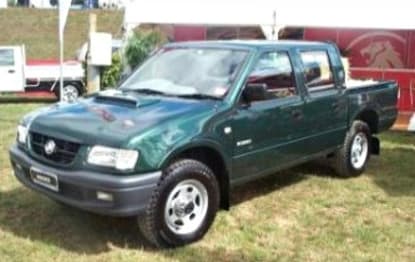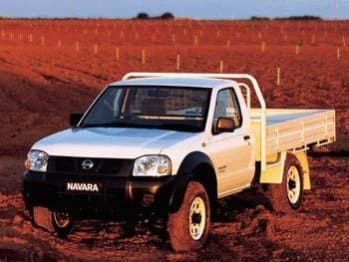
Used Holden Rodeo review: 2003
- Holden Rodeo
- Holden Rodeo 2003
- Holden Rodeo Reviews
- Holden Reviews
- Holden Commercial Range
- Holden Ute Range
- Commercial
- Ute
- Holden
- Used Car Reviews
- Buying tips
- Buyers Guide
- Tradies
Imported one-tonne utes have become the staple of local trades and businesses that want a tough work vehicle that can carry a decent load around the job site, and Holden’s Rodeo is one of the leading models. The Rodeo first showed up on the local landscape in the ’70s when Holden’s utes began to lose favour with tradies. They simply became too expensive compared to the imported utes, which despite being a bit rough and unrefined conquered the market.
While local utes have made a comeback in recent times, they’re now more a lifestyle vehicle for people who want a dual purpose daily driving weekend escape car. The imports have mostly stuck with their strength, which is their carrying capacity and their toughness on and off road.
Even so the importers have keenly watched the growth in the popularity of the local utes and have also attempted to address the demand for cool vehicles without giving away the advantage they hold in cargo capacity.
Model watch
The all-new RA Rodeo hit the market in 2003. It was bigger, more powerful, better equipped, safer and Holden also claimed it was tougher than ever before.
As with all cars looks are important in the ute market and the new Rodeo arrived with a new muscular look that was perfectly appropriate for the segment. All sat high and handsome making it difficult to pick a 2WD from a 4WD model, which ensured all had a rough and tough look on the road.
Built on a tough chassis the RA Rodeo boasted substantially increased torsional rigidity, up by as much as 60 per cent, and that equates to better crash protection and a more stable platform for better handling.
The RA’s larger external dimensions translated into more space inside the Rodeo’s new cabs, which delivered substantially more leg room, shoulder space and head room than the outgoing model. Wider and higher doors across the range made it generally easier to get in and out, with wider opening doors made it easier to get in and out of crew cabs.
Inside, the dash was what you might expect to find in a passenger car, while easy to read graphics on controls and instruments, a new four-spoke steering wheel and upgraded sound systems made the RA feel even more car-like
For power Holden offered the choice of three engines; a locally developed 2.4-litre single overhead camshaft fuel-injected four-cylinder which produced 94 kW at 4800 revs and 207 Nm at 3200 revs, a 3.5-litre all-alloy double overhead camshaft V6 that boasted peaks of 147 kW at 5400 revs and 280 Nm at 3000 revs, and a 3.0-litre turbocharged four-cylinder diesel which delivered 96 kW at 3800 revs and 294 Nm at 2400 revs.
There was a choice of manual or automatic transmissions across the range, and a choice of two or four-wheel drive, the latter with a choice of two-wheel drive, and high and low range four-wheel drive.
All models, except for the entry-level DX 2.4-litre two-wheel drive, which had coil front springs, had torsion bars at the front and heavy-duty leaf springs down back.
All models had rack-and-pinion steering, and all but the DX base model also had speed sensitive power assistance.
There were three models, the DX entry level, the LX and the range topping LT, three body styles, single cab, space cab and crew cab, with a range of two and four-wheel drive variants. In total there were 56 model variants to choose from.
In the shop
As the Rodeo is essentially a work vehicle it’s important to look for signs of damage caused in the day-to-day grind on the job site. Look carefully for dings and scrapes on the body, outside and inside.
Check for wear and tear inside from big burly bodies getting in and out. Things like rips and tears in trim, broken plastics on controls often used and sometimes abused.
Not surprisingly for a vehicle meant to carry a substantial load the Rodeo’s ride is firm, although it gets better when there’s a load in the back. It also has a large turning circle so allow plenty of room if you’re doing a U-turn.
Although it’s noisy the diesel is the pick of the engines. It’s got plenty of get up and go and returns decent fuel consumption. The V6 has even better performance, but it’s a gas-guzzler.
If you prefer the V6 it might be wise to consider switching it to dual-fuel to cut running costs. Holden has a dual-fuel system available which is a sequential vapour-injection system that offers equivalent power and performance whether on petrol or gas.
In a crash
Increased chassis rigidity proves a stable platform for responsive handling that increases the ability to avoid a crash, and the Rodeo has side intrusion bars for protection in side impacts.
ABS adds another level of crash avoidance on the LT, which also boasts dual front airbags in its list of standard features. Airbags are also optional on the LX models.
Owners say
Hugh Eastwood owns two RA Rodeos, an LX Cab chassis for work and an LT Crew cab for recreation, both with the 3.5-litre V6. The work truck is always fully loaded, but performs very well, he says. The V6 has plenty of power, the gearbox is smooth and easy to use, and the brakes have no problems stopping well over two tonnes. The LT Crew cab has all the same positive characteristics, however he finds the ride is too firm without a load and the gearing is to low for normal road use. Two major drawback with both are the massive turning circle, and very high fuel consumption – 16 L/100 km – whether loaded or not.
Steve Hoogen owns a 2004 Rodeo LX Duel-cab 4WD five-speed manual diesel long wheel base tray top and loves it. It does everything he expects of it well, with great fuel consumption – 10 L/100 km – around town and a bit better on freeway. He says he would like another gear for speeds over 80 km/h. It handles and brakes well on the road and is great off road. The ride is good with a little weight in back or four on board, but a bit hard when riding solo and empty.
Look for
• Strong masculine styling
• Roomy interior with larger cabin
• Thirsty V6 engine
• economical diesel engine top choice
• Large turning circle
• Hard ride, particularly when empty
The bottom line
• Tough work ute with good performance and roomy cabin, but gas guzzling V6 petrol engine.
Pricing
| Year | Price From | Price To |
|---|---|---|
| 2003 | $1,820 | $6,820 |
Pricing guides
Range and Specs
| Vehicle | Specs | Price* | |
|---|---|---|---|
| DX | 2.4L, ULP, 5 SP MAN | $4,070 – 5,940 | 2003 Holden Rodeo 2003 DX Pricing and Specs |
| LX | 3.2L, ULP, 5 SP MAN | $2,640 – 4,180 | 2003 Holden Rodeo 2003 LX Pricing and Specs |
| LX (4X4) | 3.0L, Diesel, 5 SP MAN | $2,750 – 4,290 | 2003 Holden Rodeo 2003 LX (4X4) Pricing and Specs |
| DX (4X4) | 2.8L, Diesel, 5 SP MAN | $2,200 – 3,410 | 2003 Holden Rodeo 2003 DX (4X4) Pricing and Specs |
Other cars to consider
$4,950
Lowest price, based on 10 car listings in the last 6 months

















